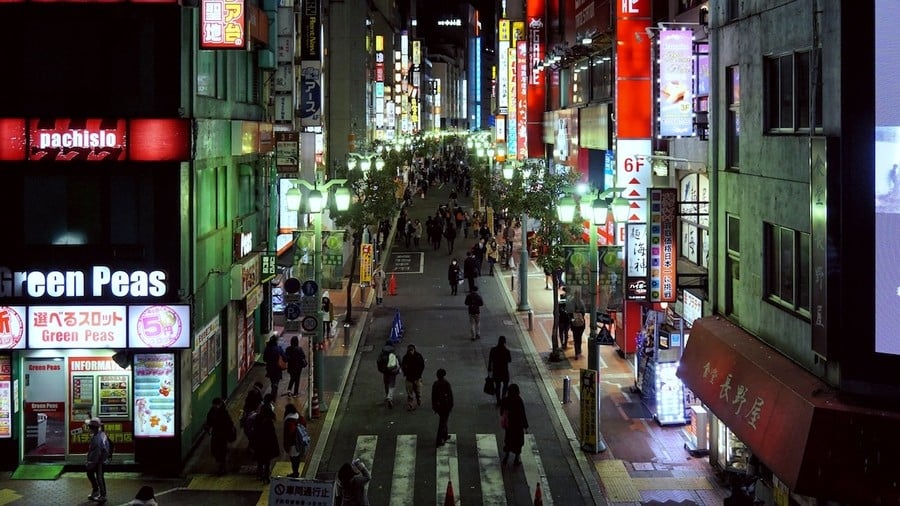
“I know Tokyo arcades are dying out, but are they easy to find?” I was asked this question recently by an author researching a Street Fighter book. Dying out?! Maybe – but there’s a long way to go.
Stand with me outside the Shinjuku Minami-guchi branch of the Taito Station arcade, next to the world’s busiest train terminal. It borders one of Tokyo’s seedier districts but, by British standards, the street is clean and the teeming crowds polite. The streetlights shine a soft green that suits the sultry night air. An enormous Space Invader hangs over “GAME” in huge letters. That’s not just some generic arcade icon – Space Invaders was Taito’s game back in 1978. Tokyo is still lit by the afterglow of the 1980s boom and the arcades have been part of it since that peak.
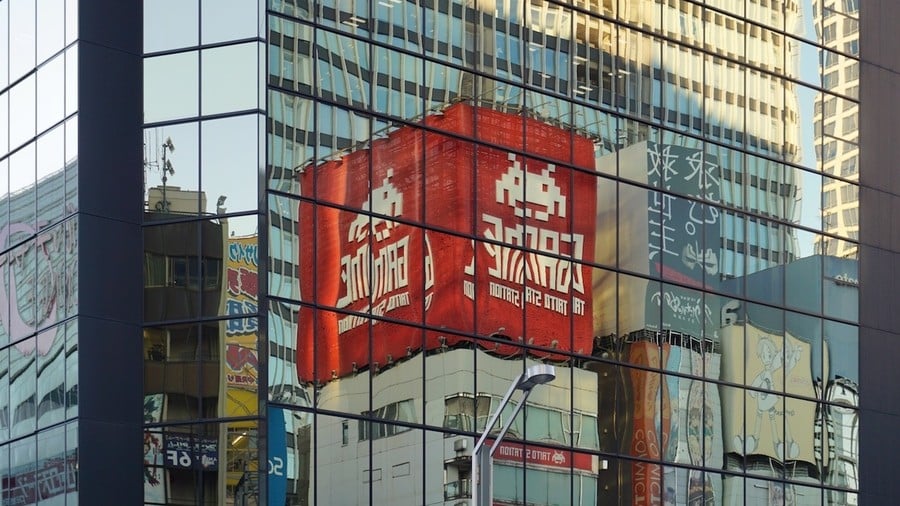
But is real gaming dead in Tokyo? Is it all crane games and Print Club? Hardly: there’s rhythm action, tate shmups, fighters from different decades sitting side by side, trading card games, insanely elaborate coin-pusher machines, intricate online mech battlers, machines you climb into, machines with console controllers hanging off the front, horse betting games you play in a reclining easy chair, traditional genre pieces and wacky bids to be the Next Big Thing.
This is Tokyo – not anime-and-manga Tokyo, not temple-and-shrine or skyscraper-and-shopping Tokyo, but arcade Tokyo. Let me be your guide.
Ground
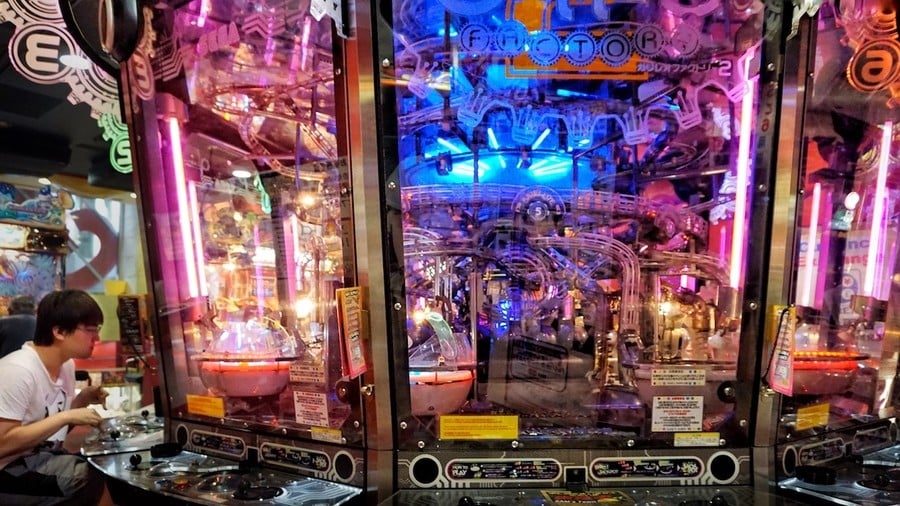
The ground floor of Taito Station is open to the street so that passers-by might drop in and drop some coins (or tap their e-money cards used on public transport). For that reason, you will see neither battered retro cabinets nor the latest otaku craze. Here you will find casual games – accessible, appealing, and sociable.
Invariably, UFO catchers (“yoofo catchers” – crane games) will be front and centre, with schoolkid lovebirds trying to grab each other prizes ranging from the predictable (soft toys) to the thoroughly bizarre (plastic models of spoons full of food).
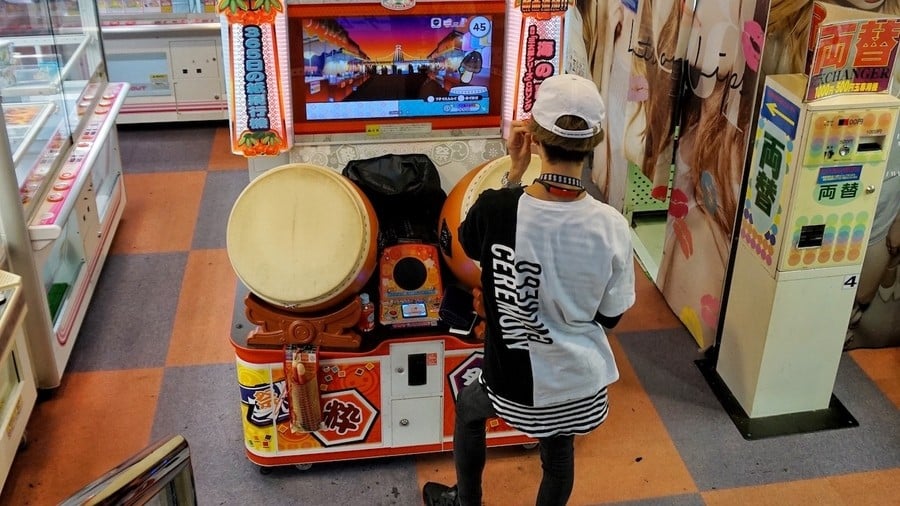
The only actual video games on the entrance level are date-friendly affairs like the Let’s Go series of two-seater benches in dark booths behind curtains. These are often pleasingly retro or sport an interesting gimmick like glasses-free 3D (Let’s Go Island) or vacuum cleaner controllers (Luigi’s Mansion).
There are no hardcore players on ground level – except maybe on Taiko Drum Master. (They’re the ones who brought their own drumsticks.) But the most important thing on the ground floor is the lift. Let’s go up and find some proper games.
Level 1
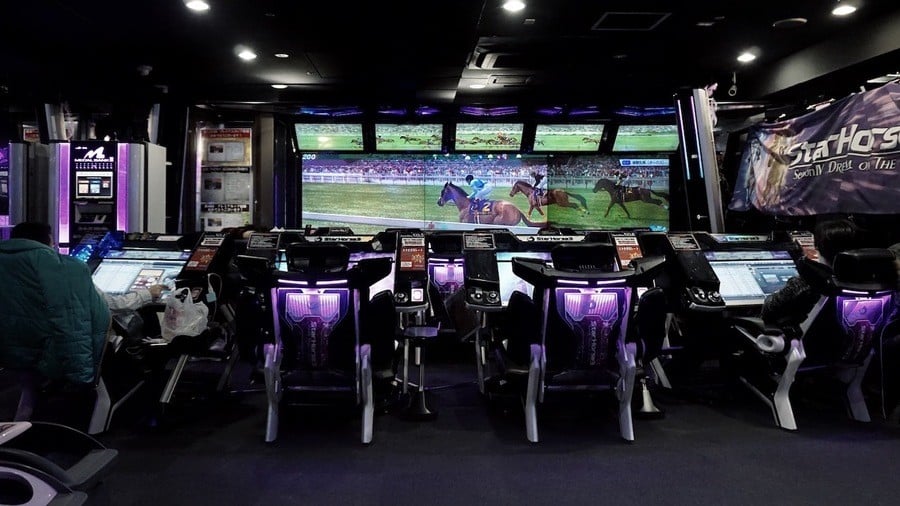
Teleport: to Ueno, a youthful district in the north-east of Tokyo. We’re in Sam’s Town, a game centre in the non-Sega-non-Taito minority. It’s dingy, smoky, and cacophonous. Now we’re getting real: if you’re on the first floor then you weren’t just passing by; you’ve come in on purpose, probably to feed some sort of unseemly addiction. Sure enough, this floor’s for medal games.
For a medal game you insert medals in place of coins. You then stand to win more medals, which you can use to play the game some more, until you’ve lost all your medals. The medals are bought for cash, but can’t be cashed in. They’re just medals. Pointless, futile medals. The most sophisticated set-ups are for virtual horse betting, featuring banks of individual consoles, reclining seats, and built-in ashtrays and cup holders to help you settle in for the long haul. Pure, private luxury, with a wall-to-wall screen showing the races in which you participate anonymously.
Luxurious, yes, but it’s Loserville – at the sad, daylightless end of the floor, dotted with suited salarymen who either don’t have anywhere better to go, or do. Let’s move on.
Level 2
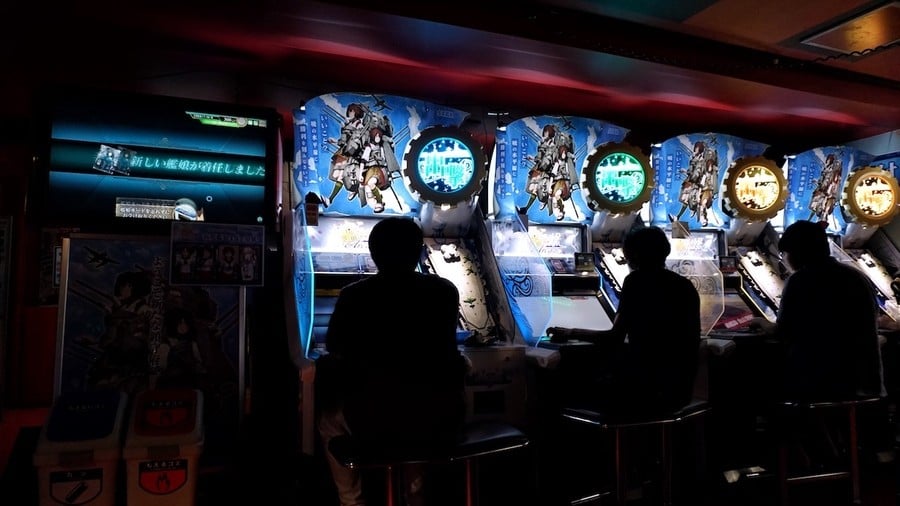
Warp zone: now we’re on floor 2 of Sega Yoyogi, a neat little arcade, well appointed for its size and not too busy. You may be relieved to see something, finally, that resembles an arcade cabinet. There are screens to look at, stools to sit on, and pretty little coinslots all puckered up waiting for you. But where are the joysticks? Welcome to the trading card games.
TCGs take many forms: maybe virtual cards are stored on your saved profile like in the aircraft-carrier/kinky-schoolgirl mashup Kantai Collection. Maybe you have actual cards which you move on a tabletop to control onscreen resources like in the pseudo historical samurai wargame Sengoku Taisen. Maybe you’re building your Panini sticker collection with World Club Champion Football. It’s pretty cool when an arcade game pukes up physical trading cards for a win. The typical TCG player looks a little older – with the disposable income to build that thick deck at his side.
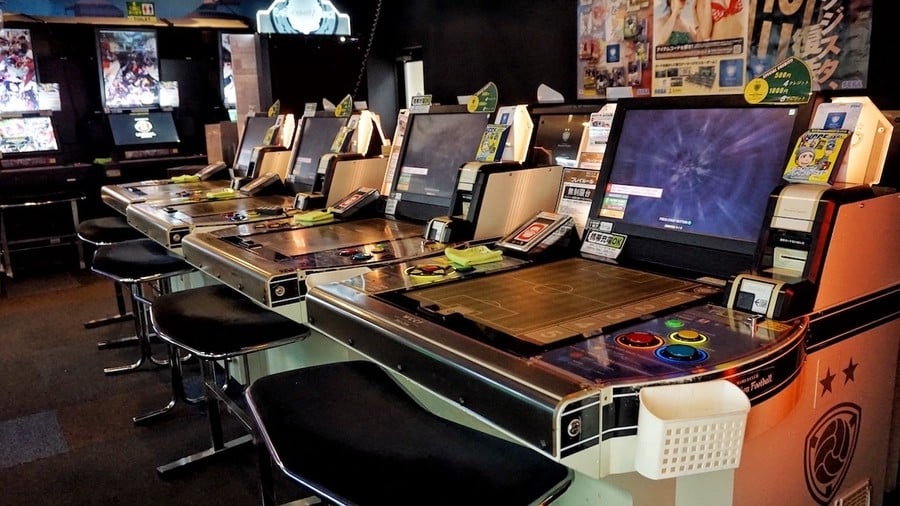
On the way up, there’s a pen-and-paper waiting list for Lord of Vermillion on a clipboard. This sort of low-tech/high-tech collision is very Tokyo, and perhaps why TCGs do so well. Anyway, let’s get in the lift.
Level 3
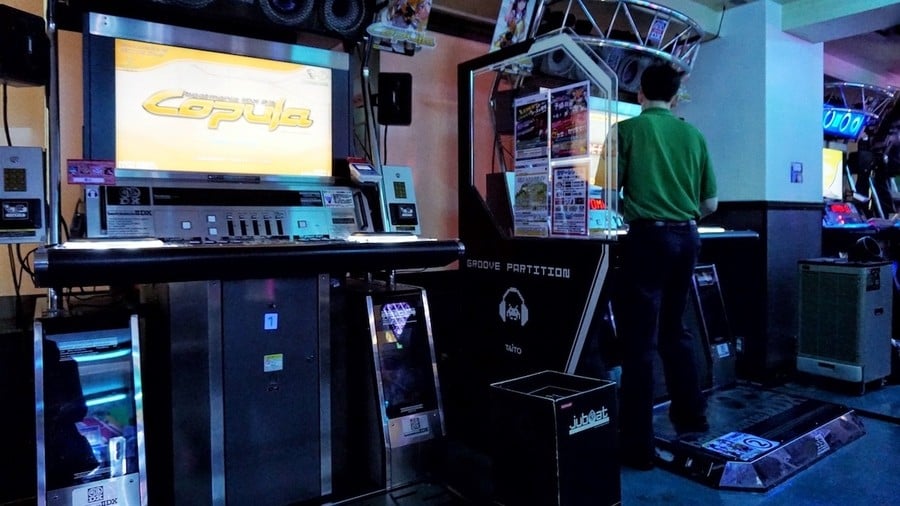
The doors slide open in Taito Station at Shinjuku south – back where we started. Their website boasts of “Shinjuku’s strongest music game corner”. That’s a lie: it’s not a corner; it’s the whole floor.
It’s time I told you something: there’s no retro floor. It’s better than that. Retro games are all over the place but they’re not treated like retro games; they’re just great games that are still great so you can still play them.
Take these music games for example. On this one floor you have Pop’n Music (1998), DrumMania 9th Mix (2003), Rhythm Tengoku (2007), Jubeat Ripples APPEND (2010), and maimai Pink (2015). It’s like someone made a rhythm action museum.
If tall card decks betrayed the financial investment of the TCG players, it’s sheer skill on this floor that betrays incredible amounts of sacrificed time. Refreshingly the vibe isn’t so severely men-only, and many of the sportily dressed, Pocari-Sweat-chugging kids here are either performing highly energised routines or practicing to perform another time.
Another lo-fi touch here: the list of new songs for Beatmania IIDX 23 Copula is a homemade Excel printout pinned to a corkboard. It feels like a personal touch: by fans, for fans.
Level 4
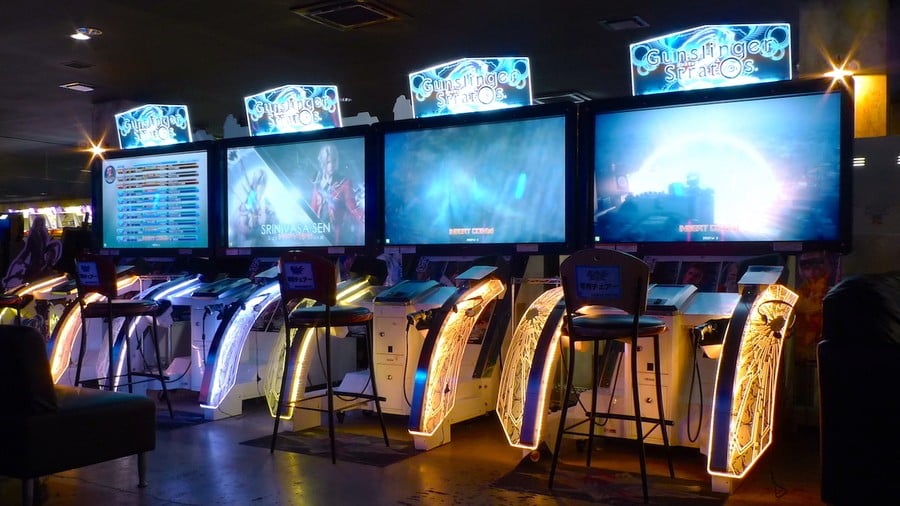
Ding! Top floor – of the famous Taito Hey in Akihabara. You’re used to the smoke and grime now, and this place somehow seems tidy and formal. Players hunch forward in orderly rows, like students in a library. In fact, there’s a shelf of thick books – strategy guides for big-name games refined and versioned up over several years. People here are inconspicuous: their clothes are plain, their belongings folded neatly into the baskets provided. They barely move as the lights flash across their concentrating faces.
The games are serious and unapologetic – not musical, not collectible, not obviously fun. They’re far from the ground floor crowd-pullers, but they’re brilliant. Gunslinger Stratos is a networked team shooter you play with two lightguns. Border Break is a mouse-and-joystick mech war with endless upgrades to earn or buy. For Gundam: Bonds of the Battlefield, you climb into a giant cockpit, closing the door behind you to play on a spherical screen.
These are the premium titles that Tokyo’s arcade gamers come to play. They’re complex and completely in Japanese, but don’t be scared off: find the tutorial mode and the graphical prompts will give you half a chance.
You did it! You made it to the core of Japanese arcade culture. Let’s head back downstairs.
Basement
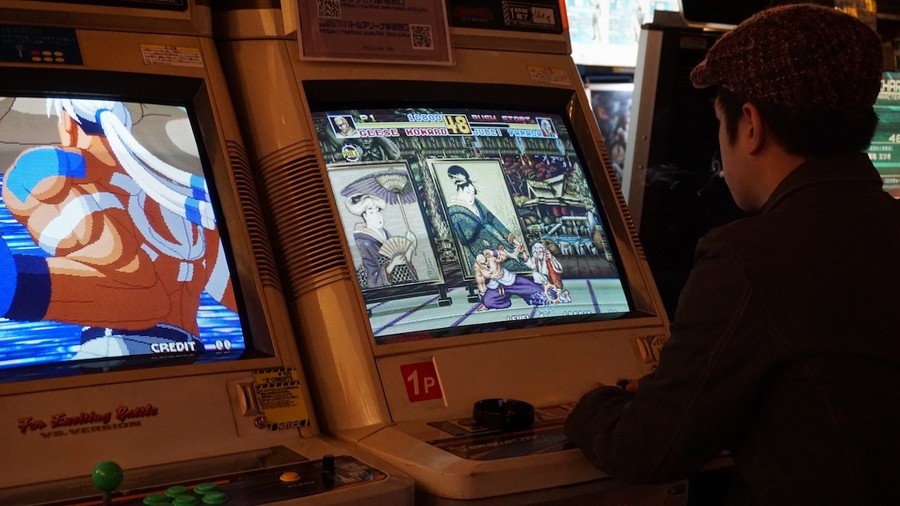
Hey, we missed our floor! We’ve ended up in the basement of Club Sega in Shinjuku. There’s a display case in the elevator lobby stacked full of Neo Geo ROMs. A handwritten cardboard sign says you can play what you want. The bottom shelf has Street Fighter 2 – and a championship belt.
When that writer called me about his Street Fighter book, he wanted to see some real tournaments. I sent him here. The door to the games room says “Battle Arena”. There are tight aisles of candy cabs. They’re running classics from the '90s like Fatal Fury and Metal Slug, and gems from the 2000s, like Ikaruga and Karous (and Metal Slug again). And of course you can play most of the Street Fighters. Alongside the oldschool cabinets, modern HD displays host Street Fighter IV and - the current king - Tekken 7.
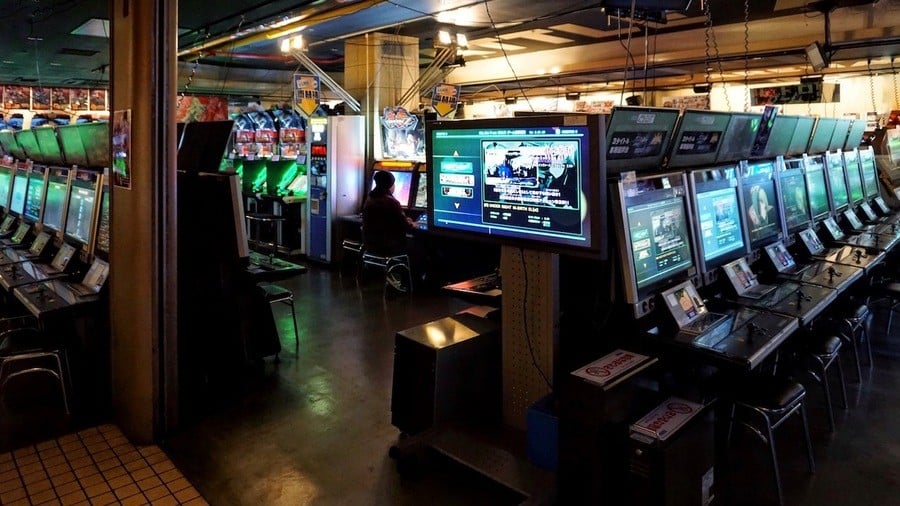
After-school kids or lunch-break office workers are training with intense focus. It’s like a gym, but with more ashtrays. They’ll play right up to the onscreen notices of closing time. Vending machines dispense bottles of milky ice tea to see them through until then.
We step back into the green streetlight under that giant Space Invader and you realise now that you stink. You’re infused with the flavour of nighttime Tokyo. This city crams its work-clothed citizens into bars and basements, pumps in smoke, stews everything in sweltering humidity, makes office days long and apartments cramped enough not to rush back to, then flashes and shouts old favourites on candy cabs in the dark.
Arcade gaming is an ingredient of this metropolis – maybe it won’t be forever, but you can certainly still taste it.
Roland Ingram runs Arcade Tokyo, a site devoted to covering the coin-op sector in Japan.




Comments 67
Well Arcades are almost completely dead so makes sense
It's nice to see that arcades are even still around in general. Times were fun in the 80's to early 90's being able to find arcades and have some good times, but now...kids of today don't even know about them (much like video stores and music stores...granted some music stores are still around). Just a shame and shows how much life was better in the past with there being more for kids to do.........BACK on topic though, it's a phase that died out in the US quite some generations ago, so it wouldn't be a surprise to see it ending over there too. Guess if people want to play the arcade machines anymore, it's time to fork over the money and purchase some for your own use, or just stick with consoles and PC.
They didn't seem to be dying when i visted Tokyo!!
In my eyes, video game arcades are dead to me. The whole reason they ever attracted my attention was because I was a kid with no money, and the games in arcades exceeded what I experienced at home on my Acorn Electron.
But now I can afford, without my parents interfering, to buy my own games machines, that provide great experiences without that guilt of forking out cash every time I 'game over'.
It'll probably never fall to the extent that it did in America, which even over here, there's still a small niche for them in bigger cities and tourist areas.
That was pretty awesome! The smoking struck me as somewhat odd, but I guess it's because I live in a state where indoor smoking is illegal.
There are still a lot of Arcade Games in my place, my favorite Arcade Machines are Dance Dance Revolution series, Para Para Paradise, MaiMai from SEGA, DrumMania series.
Too bad, a lot of DDR machines disappeared one by one in my local game arcade (Only a few still remaining, fortunately I still can play DDR X2 Arcade)
Because of this situation, I start to build my Home Arcade according to my plan. My plan is using several Best Arcade games in PS2 Japan & USA that use special controller to feel the Arcade gaming experience such as DDR series, Para Para Paradise, Beatmania IIDX, DrumMania series, Pop'n Music, Street Fighter Alpha series + III, K-1 series, etc. If I have enough budgets, I can start shopping some Special controller such as DDR Metal pad for DDR series, Rocker Band Drum kit for DrumMania Konami, Mini Pop'n Music controller for both Beatmania IIDX and Pop'n Music. For fighting games, I don't really need Arcade style joystick because I still can play with normal PS2 controller. With those items, I can spent my whole time to play almost all day long like real Arcade machines.
All those Wonderful Arcade gaming experience thanks to PS2, that has Wonderful Rhythm games from Konami and Great K-1 series + Street Fighter Anthology games.
Never thought I'd see the day they'd falter over there. They died a slow painful death here, and even here in New York, there's only one arcade that continues to get brand new games. A few others a retro arcade bars, and then dave and busters. Long cry from the early 2000s when they were all over the place around here.
Japanese arcade's are still thriving and still receive new releases, China possibly even more so. People love to write articles about how everything is doomed and dying.
Loved the arcades a teenager,I was always in them.After school hours and sometimes during school hours.If ever you wanted to find me,Royals or Johnny's Amusements was a good place to start.If not,then outside the local chippy getting up to no good.
the issue now is we have 50" tvs pc consoles that can fill the screen with great graphics & online play. & not have to throw more coins in every 10 minutes. Go arcade here & bloody everything £1- £2 a game
'Luxurious, yes, but it’s Loserville – at the sad, daylightless end of the floor, dotted with suited salarymen who either don’t have anywhere better to go, or do. Let’s move on.'
And they say such nice things about you, Roland. Jeez...
I was a little disappointed to find not too many of the classic arcade machines when I was in Japan two years ago but it was enjoyable to watch.
Until I was in Hiroshima (I think it was at least) and I found an upper floor with multiple shm'up machines in a row that I worked all the way through right up to the large double screenes Darius Burst Chronicles (you do have to twist your head).
Highlight was SDF Macross; a top down shooter.
When i went to Japan, a couple of years ago, the couple of arcades I could drag my wife to were completely packed. But never had a proper arcade over here in Guernsey so never really got in to them myself.
I sure hope they stay around long enough for me to get a salary job and paid vacation, so that I can choose where to go on vacation. I wanna play me some Taiko Drum on the streets!
I have to say, living in Brazil, getting only the worst arcades possible, paying a lot to play the minimum I'm very glad to see arcades gone. But gods, the ones in Japan looks like crazy stuff.
If arcades were truly dead, Square Enix would have dissolved Taito.
@Anguspuss
Not every PC games offers same experiences as Arcade machines. For example DDR series, Para Para Paradise, DrumMania that you need Special controller to experience Arcade gaming sensation.
I still spent some money for playing DDR X2, Para Para Paradise 2nd Mix & MaiMai Murasaki (with Online) at my Arcade Centre TimeZone. I only play them every Sunday. Oh, some Arcade Centre in my country use "Credit Card" instead Coins. The card is designed only usable on that Arcade Centre, can't be used outside that place.
Well, I don't mind to spend some money for Arcade games because they are Ready to Play machines, waiting for someone who wanna play. Beside, I can Show Off my performance during playing Rhythm games such as DDR / Para Para Paradise. And I can even play some DDR songs on Expert difficulty without seeing, just use Blindfold.
Wanna check my video ?
I was the Blue Shirt skinny guy with blindfold. I was playing Afronova on Expert from DDR SuperNOVA 2 machine (But not available anymore due to broken internally). Someone recorded me with Smartphone...
@MrPuzzlez Thanks. Yeah, the smoking is weird if you come from somewhere where it's illegal. Unfortunately, you will stink if you spend time in any typical Tokyo arcade, but there are some exceptions (and it's worth it anyway). Same goes for many restaurants, bars, etc. (Conversely, smoking on the street is a no-no except in designated areas!)
I love that arcades are popular over there! All we have in the states is Dave and Busters, and last time I went there, the button on Mario Kart that lets you use your item, didn't work
@McGruber
Is your place has DDR A ?
The newest DDR from Konami.
Too bad, in my place Surabaya still DDR X2 USA Arcade.
I'm appalled to see how the UK arcade has become grabber machines and redemption machines. Not a single arcade on the coast or in the theme parks near me!
I have to drive 3hrs to get to a decent one!
I only wish we had more stuff like this in the UK.
Maybe, as home consoles and their services become more and more convoluted, unwelcoming, and off-putting to anyone but elitist hardcore gamers and tech-heads, we might see a return of simple and pure arcades where you can just put a handful of coins and play a game for a few minutes with very little hassle. But, let's not have them all full of gambling machines and the like, because that's not an improvement on anything.
I can but dream.
@YANDMAN OK, I shamelessly indulged in Betteridge's law of headlines on this one, but I think the article shares your scepticism about them dying out (any time soon, certainly).
@Anti-Matter Plus the Gundam pod games , you aint never getting that experience at home. I actually love the fact that there is still soemthing that cannot be experienced at home, Arcades are fascinating places.
@ZurapiiYohane Arcades are popping up all over the states again.
@Lord which one do you visit?
This was a fantastic article. So much of what's described of Japan sounds like I was born on the wrong side of the world. The whole lo/hi tech thing and the way Japan does a lot of things seems to click with me more than the Western way of doing things....though that's probably because I was raised by Japanese video games
All except the smoking....a part of me likes that....at the risk of dating myself here in a world where "WE CARD" signs are hung over every store and cigs are locked in vaults behind store offices, I remember a time when almost every single store and restaurant had cigarette vending machines at the entrance/exit....just plunk in quarters and get your pack. No carding. No restrictions. No excessive taxing.
As a non-smoker, I actually prefer the modern version where you have to go out of your way to find a hint of smoke anywhere....it's pretty disgusting and physically uncomfortable to be around when you don't do that (and I say that coming from an extended family full of chain smokers.)
And yet, much as I'm glad it's all but gone around me here and wouldn't want it back...there's a part of me that likes hearing about the arcades there that's almost charming. Like a part of Tokyo never left the 80's. It feels kind of home.
Back to the real topic, there's one thing about arcades. They're casinos without prizes. They died out because they didn't represent value in the face of, of all things, Nintendo, and later, Sony. But there's something to be said for the real deal that can't be duplicated at home. The sound, the feel, the air. The neon. Arcades simply need to revolutionize their value and I think they can become relevant again. Japan gave up on the US arcade scene. We didn't have our own, they built ours and then bailed when Nintendo and Sony barnstormed the culture.
But there's a slight resurgance and this article convinced me to really take advantage of it while it's around. There's one pretty new Japanese arcade around me. The place is huge. Not 5 floors like the one in Shinjuku here, but big. And very Japanese. And a whole lot of neon.
No smoke though.
But it's got the crane games, probably 30 of them or so, maybe more if you include quarter drops. It's got some very Moe, arguably risque "design your idol" cabinets that seem pretty.....nearing "adult" content on the exterior but actually seem to be geared toward women in content. And of course the basketball and run-in-place machines. But in the center is a lot of "real" cabinets. From the sit-down racing games, to fighters, there's plenty of joysticks around. A lot of cabinets are Japanese-only titles. I got to play the Luigi's Mansion cabinet there (I promised myself if I ever saw one I'd play it, and I got my chance!), there's a bank of 2 or 3 MK8 machines, and a row of like 10 Mario & Sonic at Rio stand-up cabinets.
After this article I'm going to have to make sure to spend some time (and money) there before it goes away.....but it actually represents a NEWLY built arcade rather than a fading retro one. Perhaps a resurgence is under way of arcades in the US?
They're adding value. Instead of plunking quarters in, everything but the coin-drops is powered by store cards you pre-load at the front desk or a vending machine with credits, and you spend the credits instead of directly spending coins. Different cabinets take different amounts of credits, and credits cost different prices in peak or off peak hours. Some are outright gouging, some are good values. And then for CERTAIN machines (mostly sit-down machines like racers) you can just buy a 1 hour pass to just keep swiping. I don't think you'll be playing Street Fighter with a pass, but VirtuaRacer, you can.
And, yes, they have Pokken Tournament. And yes, it's in Japanese.
You should do a feature on China's scene.
https://www.youtube.com/watch?v=IBmrs6ecEfg
Want to live in the 80s, go to Brazil, want to live in the 90s, go to Japan. Want to continue evolving for better or worst live here. This is how life is now in terms of gaming.
@YANDMAN good video. Thanks
In the U.S., Dave and Buster's seemed to have found a niche for a while... but I'm not sure the "crappy corporate fast food and redemption games" model is completely sustainable to pay the bills for a modern arcade space.
The nostalgic "pay one price" bars that feature unlimited plays on classic machines seem to be more common in larger cities (though there is a decidedly hipster vibe to such venues that I don't think speaks to longevity).
The contrast to Japan is interesting, thanks.
@YANDMAN But the article says that the arcade scene has still got a lot of life left to it, even if it's smaller than it was. It certainly doesn't give a "doomed" vibe.
This makes me want to jump on the next flight to Tokyo! It's sad that arcades are dying. My grandfather owned a chain of bowling alleys back in the day, complete with arcades. Nothing like what's presented here but still, I spent a lot of my youth in them, mastering the games he had. I miss them so much. In my current city I call home, there really aren't many arcades. Groups of us get together for console gaming but obviously not the same. We do have a pinball arcade that has some non-pinball cabinets and live concerts (and the best perogies you'll ever find), but it's still a far-cry from what's presented here. I need to go to Japan!
Thanks for this article, I'm going to Japan later this year and will certainly use this guide as reference.
Went to some arcades in Shimokitazawa last weekend, seemed in quite good health to me.
Yo, guys. Wanna visit Surabaya (East Java, Indonesia) ?


Surabaya still have some Arcade Centre from TimeZone, Fun World, Mr Token, etc. I recommend TimeZone for better experience. And the place is inside Mall, no smoking area so you don't have to worry about cigarette smokes. There are a lot of 90's machines, some 2000's machines over there.
You can consider Surabaya as your vacation destination during this Summer holiday.
And I will waiting for you...
I'm hoping they're still abundant when I get to go to Japan in the next couple years
Kinda depressing that they are, essentially, dead in the US (Except for barcades) and they're on the decline in Japan.
When I went there for business just a month ago, there were plenty of arcades to be found. I agree with the author of the article: it's part of the flavor and won't be going away soon.
Oh if I had the money I would buy an arcade version of Taiko no Tatsujin...sigh. I can dream.
@YANDMAN for an excellent experience I visit arcade club bury, Manchester. As all the coastal ones near me Hunstanton, wicksteed, have all gone redemption or grabber.
@NEStalgia Wow, epic comment. So glad you liked the article and that the appeal of the dirty, smoky, sometimes morally questionable atmosphere. Comes over. The arcade you describe sounds pretty awesome. I have played at an arcade with that kind of card system in Singapore. It's fun and convenient, but I love getting a big stack of coins and rattling them in, too. (If you like this vibe then check out my site and my Instagram.)
@DarthFoxMcCloud Do it! The arcades aren't dying yet – don't panic.
@unoclay 👍 Have fun in Japan! My mission this summer is to see how many Sega arcades I can hit in one day. I think 20 should be possible…
The Switch killed them!
@gblock They definitely will be there in 2 years, don't worry!
Arcades won't die. Well, not, at least, until there's no one left down the (arcade) food chain to sell your old arcade machines to!
I actually found an ice cream crane that Altus made in an arcade near me a while back. And, of course, those food crane machines that can give you a jackpot of food for maybe 25 tokens or so... always nice to get a great deal out of them!
@Arcade_Tokyo Thanks! You really did a fantastic job conveying the feel of each floor. It was a fantastic read, and very evocative of the atmosphere! In a way I'd describe what you described as a "wholesome seediness". It's seedy but in a way that seedy things were in simpler times. Which at the time seemed questionable and today seems almost praiseworthy.
Yeah I was shocked when I saw the card system. I'm actually glad to hear that there's still plenty of actual coin-op machines over there. The new system defintely adds value which is what arcades need to survive, but I did hate to think that swiping replaced the plink of coins everywhere.
@retro_player_22 It's not really an either-or proposition. Sometimes balancing the good parts of what was with the improvements of what can be made better than throwing it all out just to make it all different regardless of whether it's better or worse. Today we have Switch. The single most fantastic piece of gaming hardware ever made, at least from my perspective. It's affordable (more or less) it's convenient, and it has tons and tons of value over the arcades of old and even most prior consoles. It can even play those 90's games from the ACA cabinets in the arcades! But that doesn't mean there isn't value to the old way of doing things and that the experience of arcade environments can be matched outside the arcade. If you haven't spent some time under the glare of neon and tacky carpeting with a cacophony of sound that's deafening and incomprehensible, you might not understand it, but neither Switch nor PS5, nor Occulus on a $4000 PC rig will ever duplicate that magic. Fortunately at least some places, even here, still seem to get it. We can talk about dying arcades, and in the US that has certainly been true, but we're also not talking about the fact that they're still building new ones... big, fancy, expensive new ones. It's not all a story of run down 1970's places with flickering lights waiting to close. I don't know if it will last, or how long it can last, but it exists!
Most gambling now happens on smart phones and video poker machines. But casinos and card tables still thrive.
Movie watching in home theaters is how most movies are consumed, but theaters still built their (awful) niche!
No reason gaming can't aim for the same.
@Arcade_Tokyo I cannot wait. If you're expert at Japan, I welcome any recommendations of any sort. Doing lots of reading currently to learn the ropes.
I just spent the last two weeks in Tokyo on business and used my downtime to check out the Akihabara arcade scene. I intended to only go once as I wanted to do some sightseeing elsewhere while I was there but dang, Akihabara's arcades are addicting to an old school arcade junkie like me. I went back 5 times and spent about 25 hours there. Infectious atmosphere for a guy like me if ever there was one. If the scene is dying, man I can't imagine how active it used to be.
Mind blowing article for me!!! Those pictures are the coolest thing Ive seen in forever! I would love to be able to be in that horse racing room betting on horses. Those modern arcade pictures bring out the kid in me again. I'd give anything to be there. USA is missing out big time.
side notes:
1.Japan has a lot of horse racing games for the SNES that I wish would get translated.
2. My friend and I like to go to youtube and look up sumo fights. We dont know Japanese or any of the fighters so it's fun to watch and bet a wager on the outcomes.
When I was a kid and even as a young teenager there were loads of arcades around. They were great and relatively cheap to play. I miss those days. Turtles, Star Wars, Moonwalker, Street Fighter 2, Bubble Bobble and many, many more. I think the SNES/Megadrive era was the beginning of the end for arcades. Now there's only a few scattered here and there and they're very expensive.
Level 1 in this article is just sad and you're right, pointless too.
This was a great read, played out kind of like a paper & pen adventure game. Good job sir!
@Priceless_Spork Thanks! Really glad you liked it – I worked hard on the pictures. You can see loads more on my Instagram: arcade.tokyo.
You're right about horse racing games. They've been popular since the famicom – and even earlier in the arcade.
@SLIGEACH_EIRE Let's assume level 1 helps pay for the basement so it's not all bad 😁
@unoclay Keep an eye on my site, which I hope to get updated more frequently in the near future. Also 9pp.co/tgc might give you some inspiration. (And my Instagram at the risk of repeating myself…)
I was asked this question recently by an author researching a Street Fighter book. Dying out?! Maybe – but there’s a long way to go.
Street Fighter's Arcade success specifically would be hindered by Capcom's decision to not put Street Fighter 5 in Arcades (personally I don't think SF5 is that good of a game but that's besides the point). They have funneled a lot of money into turning SF5 into an eSport however.
The top Arcade fighters in Japan as I understand it are "Blazblue: Central Fiction", Tekken 7, and the Gundam one (I don't know it's whole name).
Arcades are far from dying in Japan, among some other places. True 'video games' are indeed harder to find every year. Besides Tokyo, there are some good arcades in the other big Japanese cities too people tend to forget. I highly recommend:
A-Cho in Kyoto, about 5-10 minutes from central station by bus. Games are 50 yen, personnel is helpful, and the game selection is a good mix of classics and modern games. No crane games or gambling-oriented stuff, just video games. No smoking inside, and they also have a recording system and YouTube channel, uploading fighting game competitions and friendly matches on request among other things. Their classic game cabinets don't have multiple games ready, but ask a personnel and they can swap the game on request! http://www.a-cho.com/
Monte-50 in Osaka. Very similar to A-Cho but has more floors and several more types of games. Also 50 yen per play and fighting game oriented, but also has more shmup cabinets ready on the 4th floor. Atmosphere among players is fun, also good personnel, and many cash exchangers. The smoke is VERY bad here though. http://www.monte50.com/
@Slaz I have seen and heard lots of good stuff about the scene in Osaka and would love to check it out one day. When I do, I'll definitely go to Monte-50!
This was an amazing article. Very evocative.
Great article, a lot of fun to read and reminisce about smoky, slightly seedy arcades. I learned a good portion of my street smarts hanging around the Gold Mine and the Golden Nugget. Good times.
Man, I wish the states had those kinds of arcades still. I remember going to an arcade back when I lived in California that was HUGE and filled with only Japanese machines. My current self would be absolutely enthralled, but at the time I was maybe 6 or 7 and I was just complaining that "everything's in Japanese!!"
As it turns out, if it's all in Japanese, it's where you want to be. All we have now are Dave and Busters which, I kid you not, did not have a Pac-Man or Galaga machine, except at the very front which only took quarters for charity, but you don't bring quarters with you when you're going to an all-digital arcade, now do you? The place where I go to for local smash tournaments does have a small arcade and a TON of rhythm games though, so that's cool. The only problem is that I live so far away, whenever I go I only play smash to get practice in :/
@Lord Ah interesting, iv'e not heard of this one. I have my own private home arcade but its not huge or anything, Just eight machines. My mate has a good one in Somerset 'Timewarp Arcade' they have about 45 machines and a couple of pins, plus air hockey and lots of classic consoles and systems set-up. Bit of a drive for you but its a cool place.
https://www.youtube.com/watch?v=oJeEhQRo9XY
There's a bowling alley called Tenpin Acton in West London which has a decent selection of mostly pretty new arcades. It mostly caters to the kind with large gun attachments or cabs to sit in (like Star Wars Battle Pod).
When I visited Tokyo I got away with dragging the wife to one arcade so that I could play a game of King of Fighters. Trip to Japan wouldn't have been complete without it.
Ironically it has a revival in my country, Holland (according to the News). Well, I wouldn't call 6 arcades much, but its a start.
@NEStalgia @Arcade_Tokyo @YANDMAN @BionicDodo @impurekind Hey guys. I think its just the fact that the arcade industry is so clueless here. I managed Las Vegas Soho (in the Soho area of London, England) and we are doing great with import games like Taiko, Jubeat, Sound Voltex, Street Fighter, Bishi Bashi etc. Come check us out if you are ever in Central London!
@7ten I will next time I’m in London!
Show Comments
Leave A Comment
Hold on there, you need to login to post a comment...